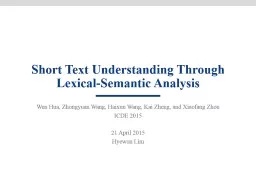

Wen Hua Zhongyuan Wang Haixun Wang Kai Zheng and Xiaofang Zhou ICDE 2015 21 April 2015 Hyewon Lim Introduction Problem Statement Methodology Experiment Conclusion Outline 2 ID: 156677
Download Presentation The PPT/PDF document "Short Text Understanding Through Lexical..." is the property of its rightful owner. Permission is granted to download and print the materials on this web site for personal, non-commercial use only, and to display it on your personal computer provided you do not modify the materials and that you retain all copyright notices contained in the materials. By downloading content from our website, you accept the terms of this agreement.
Slide1
Short Text Understanding Through Lexical-Semantic Analysis
Wen Hua,
Zhongyuan
Wang,
Haixun
Wang, Kai Zheng, and
Xiaofang
Zhou
ICDE 2015
21 April 2015
Hyewon LimSlide2
IntroductionProblem Statement
Methodology
ExperimentConclusion
Outline
2
/24Slide3
Characteristics of short texts
Do not always observe the syntax of a written language
Cannot always apply to the traditional NLP techniquesHave limited context
The most search queries contain <5 wordsTweets have <140 characters
Do not possess sufficient signals to support statistical text processing techniques
Introduction
3
/24Slide4
Challenges of short text understanding
Segmentation ambiguity
Incorrect segmentation of short texts leads to incorrect semantic similarity
Introduction
April in
paris
lyrics
Vacation
april
in
paris
{
april paris lyrics}{april in paris lyrics}
{vacation april paris}{vacation april in paris}
Book hotel
california
Hotel California eagles
vs.
vs.
4
/24Slide5
Type ambiguity
Traditional approaches to POS tagging consider only lexical features
Surface features are insufficient to determine types of terms in short texts
Introduction
pink
songs
pink
shoes
vs.
watch
free movie
watch
omegavs.instanceadjective
verbconcept5/24Slide6
Entity ambiguity
Introduction
watch
harry potter
read
harry potter
vs.
Hotel California
eagles
Jaguar
cars
vs.
6
/24Slide7
IntroductionProblem Statement
Methodology
ExperimentConclusion
Outline
7
/24Slide8
Problem definition
Does a query “book Disneyland hotel
california” mean that “user is searching for hotels close to Disneyland Theme Park in California”?
Problem Statement
Book Disneyland hotel
california
Book
Disneyland
hotel
californiaBook[v] Disneyland[e] hotel[c] california
[e]Book[v] Disneyland[e](park) hotel[c] california
[e](state)
1) Detect all candidate terms
{“book”, “
disneyland
”, “hotel
california
”,
“hotel”, “
california
”}
2) Two possible segmentations:
{
book
disneyland
hotel
c
alifornia
}
{
book
disneyland
hotel
california
}
“Disneyland” has multiple senses:
Theme park
and
Company
8
/24Slide9
Short text understanding = Semantic labeling
Text segmentation
Divide text into a sequence of terms in vocabularyType detection
Determine the best type of each termConcept labelingInfer the best concept of each entity within context
Problem Statement
9
/24Slide10
Framework
Problem Statement
10
/24Slide11
IntroductionProblem Statement
Methodology
ExperimentConclusion
Outline
11
/24Slide12
Online inference
Text segmentation
How to obtain a coherent segmentation from the set of terms?Mutual exclusion
Mutual reinforce
Methodology
12
/24Slide13
Online inference (cont.)
Type detection
Chain Model
Consider
relatedness between consecutive
terms
Maximize
total score of consecutive terms
Pairwise
Model
Most related terms might not always be adjacentFind the best type for each term so that the Maximum Spanning Tree of the resulting sub-graph between typed-terms has the largest weightMethodology
13/24Slide14
Online inference (cont.)
Instance disambiguation
Infer the best concept of each entity within context Filtering/re-rank
of the original concept cluster vector Weighted-Vote
The
final score of each concept cluster is a combination of its original score and the support from other terms
Methodology
14
/24
hotel
california eagles<animal, 0.2379><band, 0.1277>
<bird, 0.1101><celebrity, 0.0463>…hotel californiaeagles
<singer, 0.0237><band, 0.0181><celebrity, 0.0137><album, 0.0132>…<band, 0.4562><celebrity, 0.1583>
<animal, 0.1317><singer, 0.0911>
…
WVAfter normalization
:Slide15
Offline knowledge acquisition
Harvesting IS-A network from
Probase
Methodology
http://research.microsoft.com/en-us/projects/probase/browser.aspx
15
/24Slide16
Offline knowledge acquisition (cont.)
Constructing co-occurrence network
Between typed-terms; common terms are penalized
Methodology
Compress network
Reduce cardinality
Improve inference accuracy
16
/24Slide17
Offline knowledge acquisition (cont.)
Concept clustering by k-
MediodsCluster similar concepts contained in
ProbaseRepresent the semantics of an instance in a more compact manner
Reduce the size of the original co-occurrence network
Methodology
Disneyland
<theme park, 0.0351>, <amusement park, 0.0336>,
<company, 0.0179>, <park, 0.0178>, <big company, 0.0178>
<{theme park, amusement park, park}, 0.0865>,
<{company, big company}, 0.0357>
17
/24Slide18
Offline knowledge acquisition (cont.)
Scoring semantic coherence
Affinity Score Measure semantic coherence between typed-terms
Two types of coherence: similarity, relatedness (co-occurrence)
Methodology
18
/24Slide19
IntroductionProblem Statement
Methodology
ExperimentConclusion
Outline
19
/24Slide20
BenchmarkManually picked 11 terms
April in
paris, hotel
california, watch, book, pink, blue, orange, population, birthday, apple foxRandomly selected 1,100 queries containing one of above terms from one day’s query log
Randomly sampled another 400 queries without any restriction
Invited 15 colleagues
Experiment
20
/24Slide21
Effectiveness of text segmentation
Effectiveness of type detection
Effectiveness of short text understanding
Experiment
Verb, adjective, …
Attribute, concept and instance
21
/24Slide22
Accuracy of concept labeling
AC: adjacent context; WV: weighted-vote
Efficiency of short text understanding
Experiment
22
/24Slide23
IntroductionProblem Statement
Methodology
ExperimentConclusion
Outline
23
/24Slide24
Short text understanding
Text segmentation: a randomized approximation algorithm
Type detection: a Chain Model and a Pairwise ModelConcept labeling: a Weighted-Vote algorithm
A framework with feedbackThe three steps of short text understanding are related with each other
Quality of text segmentation > Quality of other steps
Disambiguation > accuracy of measuring semantic coherence
> performance of text segmentation and type detection
Conclusion
24
/24